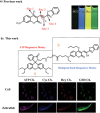Multifunctional Fluorescent Probe for Simultaneous Detection of ATP, Cys, Hcy, and GSH: Advancing Insights into Epilepsy and Liver Injury
- PMID: 39887673
- PMCID: PMC11923924
- DOI: 10.1002/advs.202415882
Multifunctional Fluorescent Probe for Simultaneous Detection of ATP, Cys, Hcy, and GSH: Advancing Insights into Epilepsy and Liver Injury
Abstract
Adenosine triphosphate (ATP) is a critical intracellular energy currency that plays a key role in various cellular processes and is closely associated with numerous diseases. Similarly, biothiols such as glutathione (GSH), cysteine (Cys), and homocysteine (Hcy) are integral to many physiological and pathological processes due to their strong redox properties. Simultaneous discrimination and detection of ATP and biothiols offer valuable insights into the pathogenesis of conditions such as epilepsy and liver injury. This study introduces the first fluorescent probe, BCR, designed for multifunctional detection of ATP, GSH, Hcy, and Cys. With outstanding optical properties, excellent biocompatibility, high selectivity, and superior sensitivity, probe BCR enables effective imaging of ATP and biothiol dynamics in vivo. Moreover, probe BCR successfully visualizes changes in ATP, GSH, Hcy, and Cys levels in a PTZ-induced epileptic zebrafish model and an APAP-induced mouse liver injury tissue section model. These findings underscore the significant potential of probe BCR for early disease diagnosis and therapeutic applications.
Keywords: adenosine triphosphate; biothiols; fluorescent probe; simultaneous sensing.
© 2025 The Author(s). Advanced Science published by Wiley‐VCH GmbH.
Conflict of interest statement
The authors declare no conflict of interest.
Figures








Similar articles
-
Novel Coumarin-Based Fluorescent Probe for Tracking Cys, GSH, and Hcy Dynamics in Lysosomes under Oxidative and Hyperosmotic Stress.Anal Chem. 2025 Jul 15;97(27):14620-14628. doi: 10.1021/acs.analchem.5c02130. Epub 2025 Jul 2. Anal Chem. 2025. PMID: 40599061
-
A highly effective curcumin-based fluorescent probe with single-wavelength excitation for simultaneous detection and bioimaging of Cys, Hcy and GSH.Spectrochim Acta A Mol Biomol Spectrosc. 2025 Jan 15;325:125108. doi: 10.1016/j.saa.2024.125108. Epub 2024 Sep 7. Spectrochim Acta A Mol Biomol Spectrosc. 2025. PMID: 39270367
-
A mitochondria-targeted fluorescent probe for discrimination of biothiols by dual-channel imaging in living cells and zebrafish.Spectrochim Acta A Mol Biomol Spectrosc. 2024 Dec 5;322:124846. doi: 10.1016/j.saa.2024.124846. Epub 2024 Jul 18. Spectrochim Acta A Mol Biomol Spectrosc. 2024. PMID: 39059262
-
Multi-signal fluorescent probe for simultaneous differentiation and imaging of Hg2+, Cys, Hcy, and GSH in living cells and zebrafish.J Hazard Mater. 2025 May 5;488:137427. doi: 10.1016/j.jhazmat.2025.137427. Epub 2025 Jan 27. J Hazard Mater. 2025. PMID: 39884041
-
BODIPY-Based Fluorescent Probes for Biothiols.Chemistry. 2020 Apr 1;26(19):4172-4192. doi: 10.1002/chem.201904470. Epub 2020 Jan 21. Chemistry. 2020. PMID: 31769552 Review.
References
-
- Chen H., Zhang Y.‐H. P. J., Crit. Rev. Biotechnol. 2021, 41, 1826403. - PubMed
-
- Jun Y. W., Wang T., Hwang S., Kim D., Ma D., Kim K. H., Kim S., Jung J., Ahn K. H., Angew. Chem., Int. Ed. 2018, 57, 10142. - PubMed
-
- Fang Y., Shi W., Hu Y., Li X., Ma H., Chem. Commun. 2018, 54, 5454. - PubMed
-
- Fortibui M. M., Yoon S. A., Yoo S. Y., Son J. Y., Lee M. H., Coord. Chem. Rev. 2024, 510, 215800.
-
- Seino S., Miki T., Prog. Biophys. Mol. Biol. 2003, 81, 133. - PubMed
MeSH terms
Substances
Grants and funding
LinkOut - more resources
Full Text Sources
Medical
